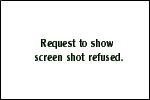





|
Review of
Geometry Blaster
 Published by: Knowledge Adventure
Published by: Knowledge Adventure
Year: 1996
Platform Information: Mac
Age Range: 10 to adult
Reviewer: Brian King and Megan Murray
Is the Game Mathematical?
Geometry Blaster is designed to explore the contents of standard middle and high school geometry curricula. Much of the game presents worksheet-type problems and a quick way to look up the answers if need be. Success in completing the six activities depends on the player's ability to identify and use geometric terms, shapes, and theorems. For example, one concentration-type memory game involves flipping squares in order to pair a written term (e.g., "obtuse angle") with a matching picture of that term (e.g., a drawing of an angle that is larger than 90 degrees). Proof Palace asks the player to arrange theorems into the proper order to yield a correct proof, while N-Gon Mountains require the answering of multiple choice questions. If the player is not familiar with terminology she can consult computerized text books, a glossary, or tutorials within the software. These activities rely on the presentation of text book material as the primary means to educate the player, and drill is the main means of exploring the geometry presented. Sadly, the power of the computer is not utilized as a tool to enhance the understanding of concepts of geometry.
Pit of Dispair is an activity with less of a text book feel, but the educational value is a bit difficult to pin down. In this game the player must hit a target by bouncing a beam off a wall at a particular angle. While this encourages players to think about and estimate angles, it is easy to resort to a trial-and-error-only method. Once players have sucessfully visited the five areas of the game, it is time to visit the most interesting puzzle in Geometry Blaster: Dimension Machine. Here you must match each of 5 nets (two-dimensional patterns that fold up into boxes or cubes) to the matching cubes by visualizing how 2D nets fold up into 3D boxes.
There are also several areas that are available for free exploration. In the Geoboard area you can construct and explore lines, angles and shapes, which are defined and measured by the computer as they are drawn. For example, if a triangle is drawn, the computer identifies the points A, B, and C, names the shape triangle ABC, and gives the measurement of each angle, as well as the area and perimeter of the shape. The player is given the opportunity to draw in positive and negative quadrants of a grid, giving experience with coordinate geometry as well. Another area allowing for exploration and construction is the tangram area, where players choose among the seven traditional tangram shapes to make pictures or designs, or to fill in the lines of pre-existing designs. Visualizing how shapes can fit into these pictures by rotating them and flipping them can be quite challenging. It is unfortunate that these components are not incorporated into the actual game play.
Is the Game Equitable?
Compared to industry standards, there seems to have been some attention given to creating an game that appeals to both girls and boys. The protagonist is a friendly, not overly-hip, slang-speaking girl. She is accompanied by Zoid, a sometimes-funny, over-intelligent, jargon-speaking creature, who is almost charismatic enough to care about. Although these characters will attract interest I suspect that they will fail to be enough to keep most players engaged. Geometry Blaster's focus on terminology, and the presentation of material through flash card-type drills and multiple choice activities does not invite children with a variety of learning styles. Finally, while many of the activities have an either-know-it-or-you-don't flavor which doesn't seem to encourage collaborative play, most of the activities are not characterized by time pressure, allowing room for mathematical thought and discussion.
Is the Game a Good Game?
This is a game for players who want to review "an entire year of high school geometry," or to avoid traditional teaching and learn it via computer. Although there is a game goal (saving the land of Dimensia from the Geometrons by restoring it to 3 dimensions), the storyline is not motivating. Instead, the how much of Dimensia has been saved merely becomes a means to keep track of game progress, reducing Geometry Blaster to a series of activities contained within a weak narrative.
One is free to choose among the different areas, activities, and three levels of difficulty. The only restriction is that you can't visit the final area until you have successfully completed each of the other activities. This kind of choice can allow players who are frustrated with one area to visit another and continue to make progress towards the game goal. However, we worry that the math activities are repetitious, and that the "you either know the answer or you don't" approach may create math anxiety in some players. Although Geometry Blaster presents playful characters in a fanciful context (seeing a typically 3D world reduced to two dimensions and slowly restored to three), the presentation of the mathematics does not encourage players to learn geometrical ideas in a meaningful way. It would not be surprising if some players were turned off to geometry after playing Geometry Blaster.

Back to the top of the page
|



